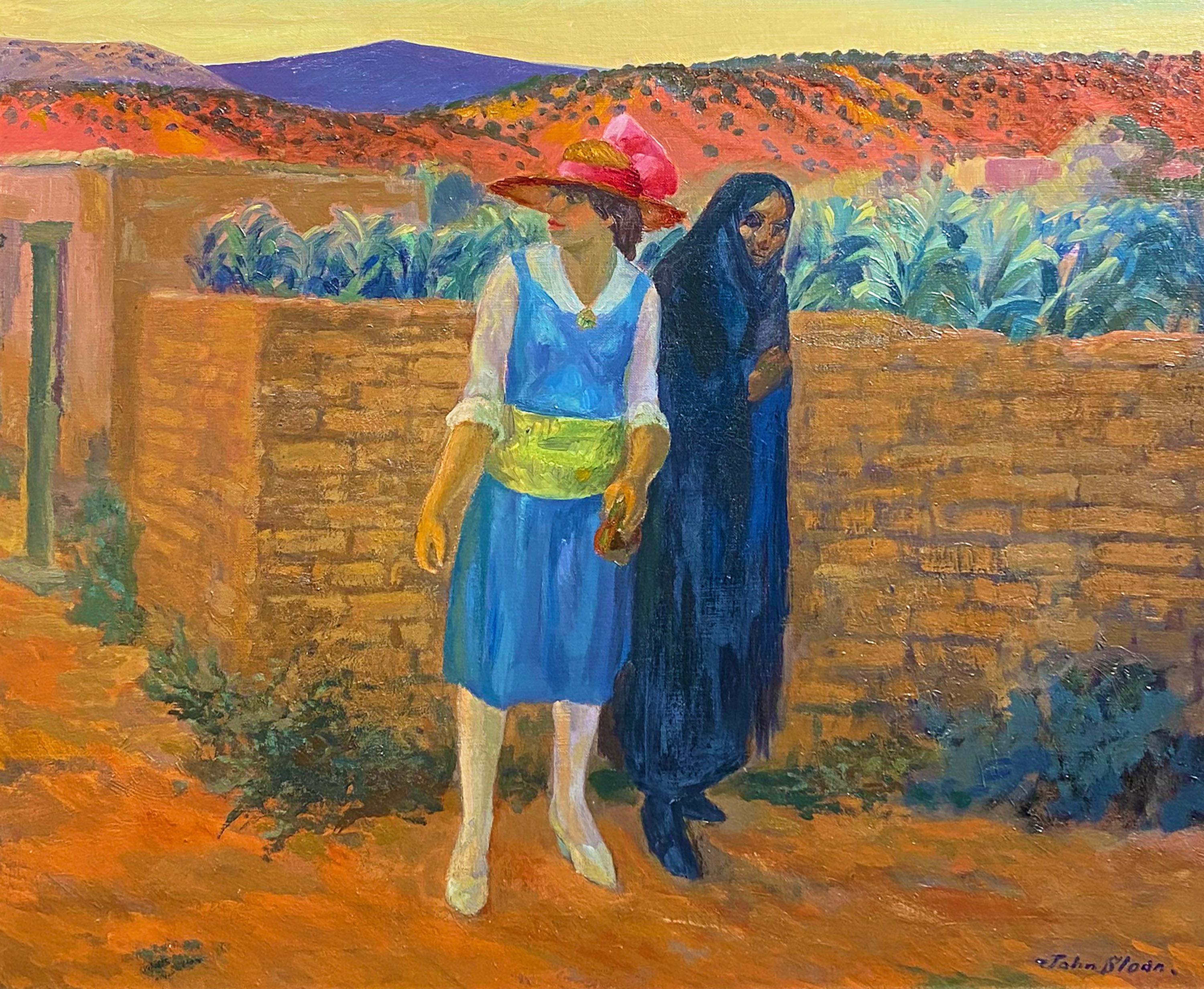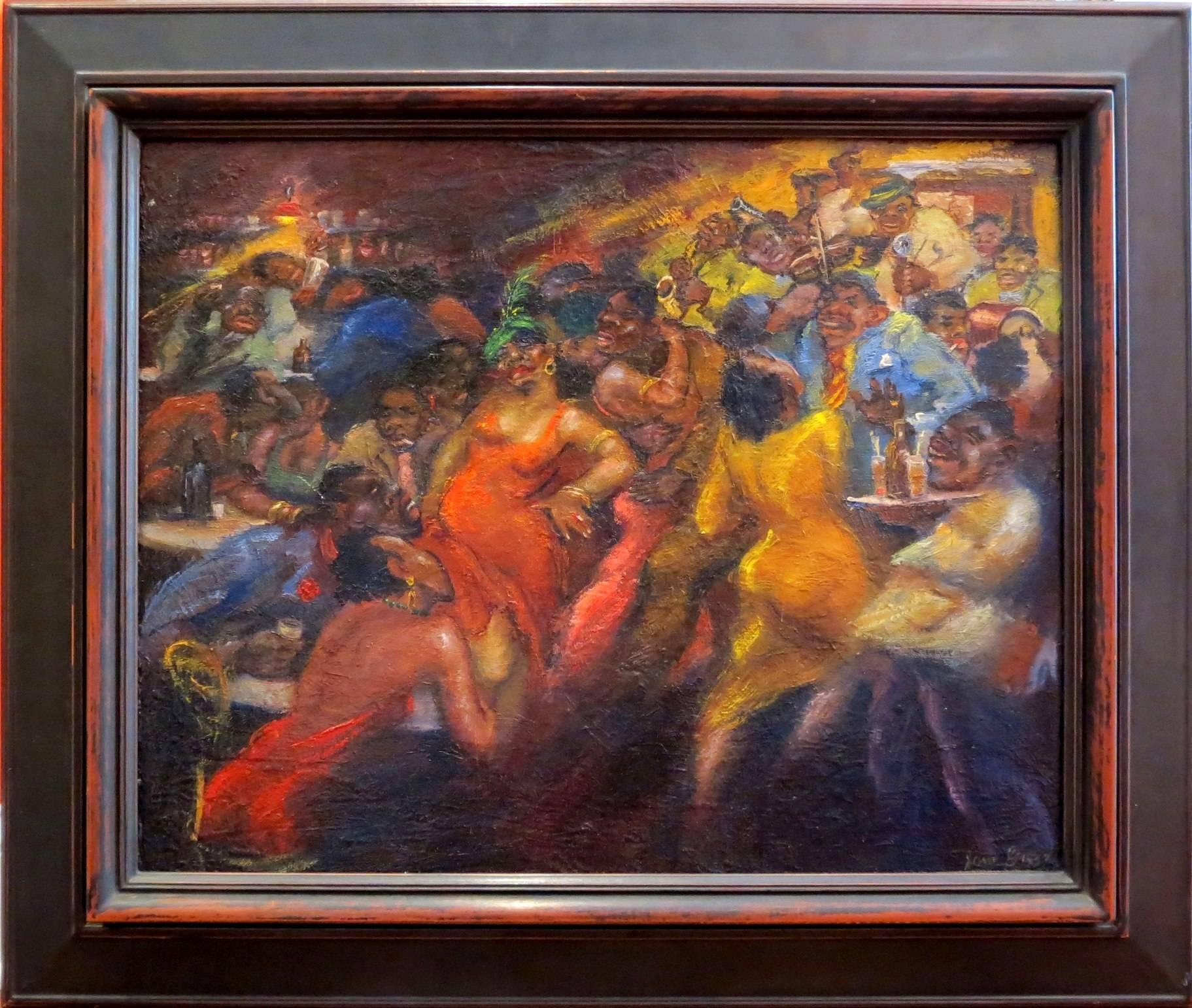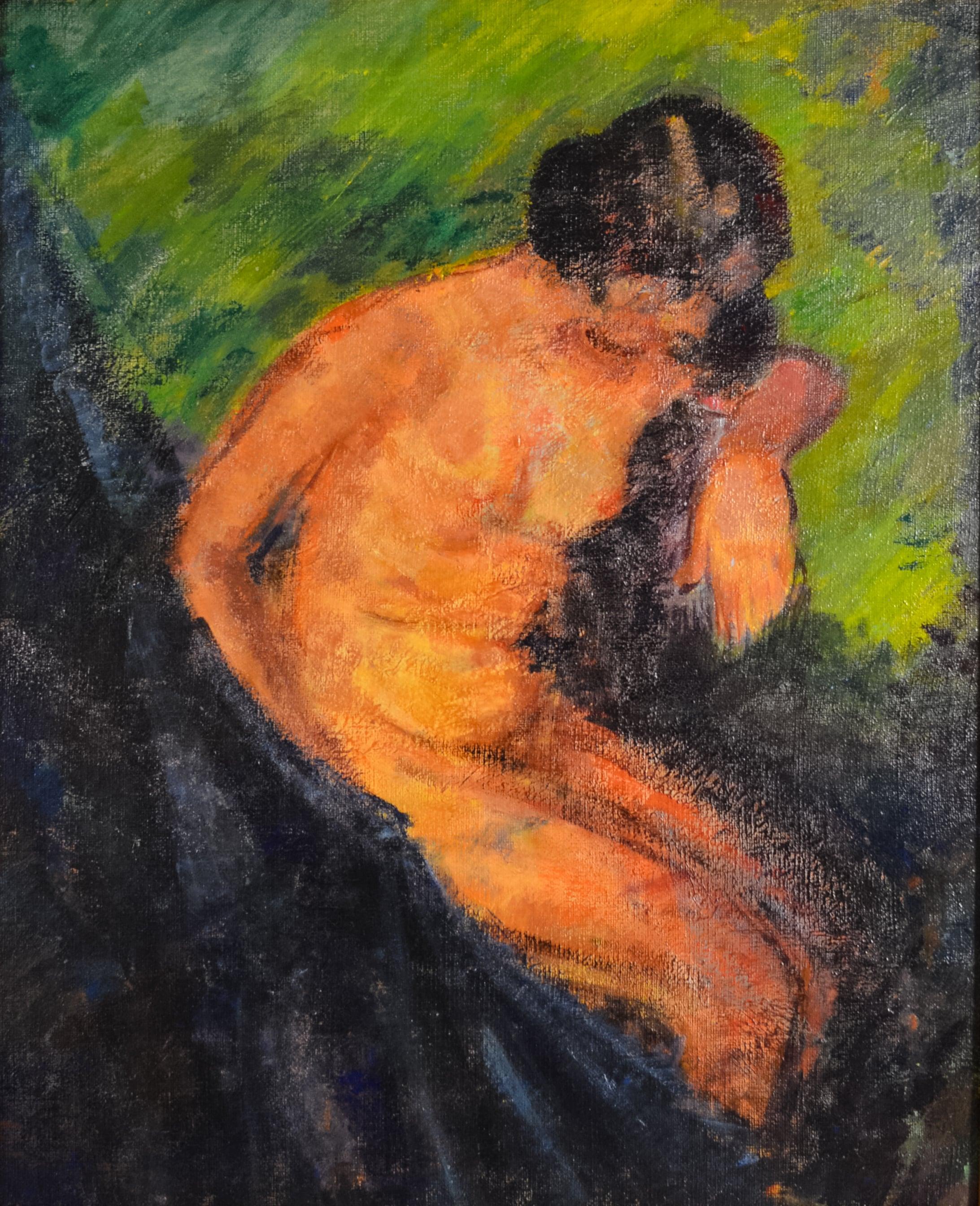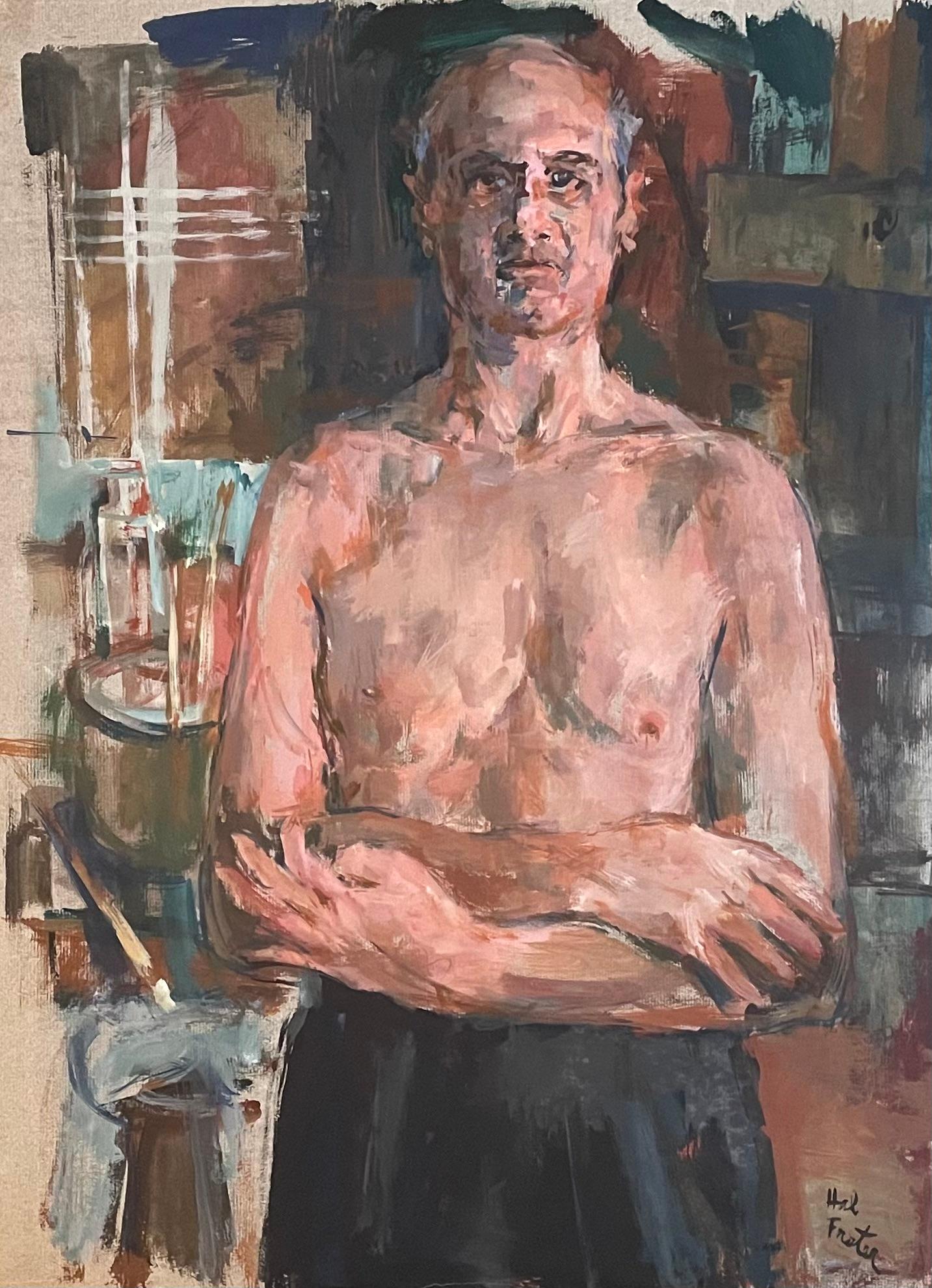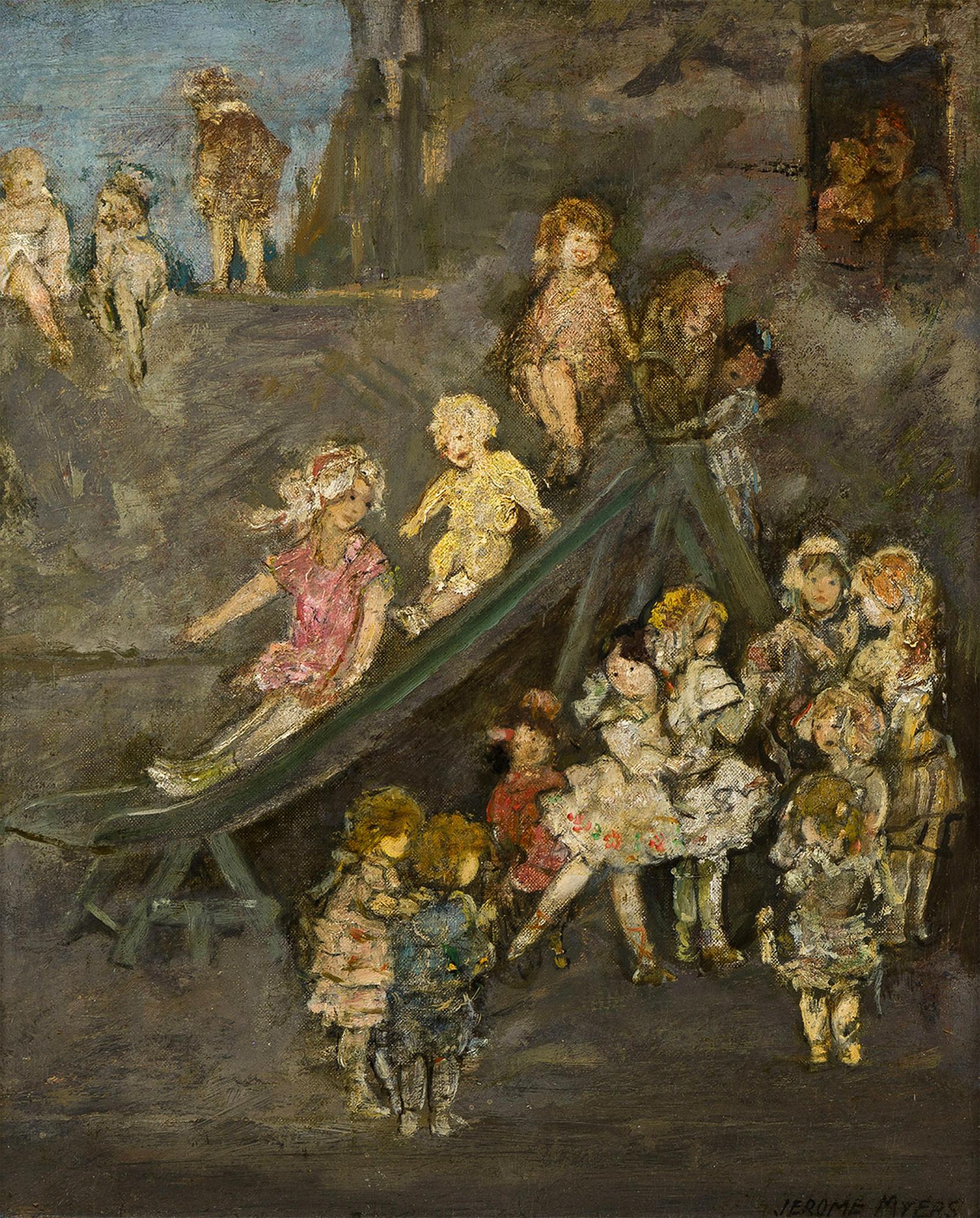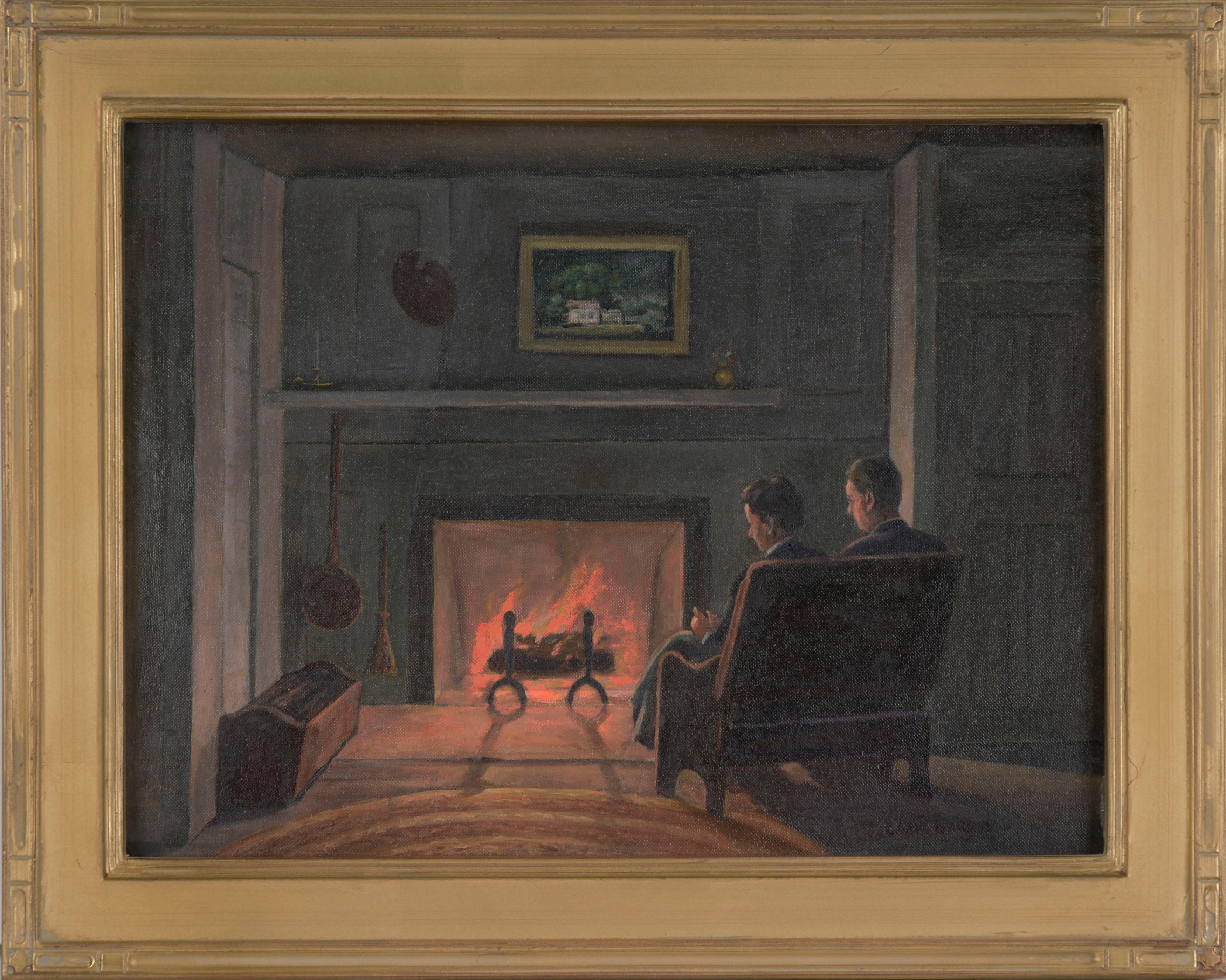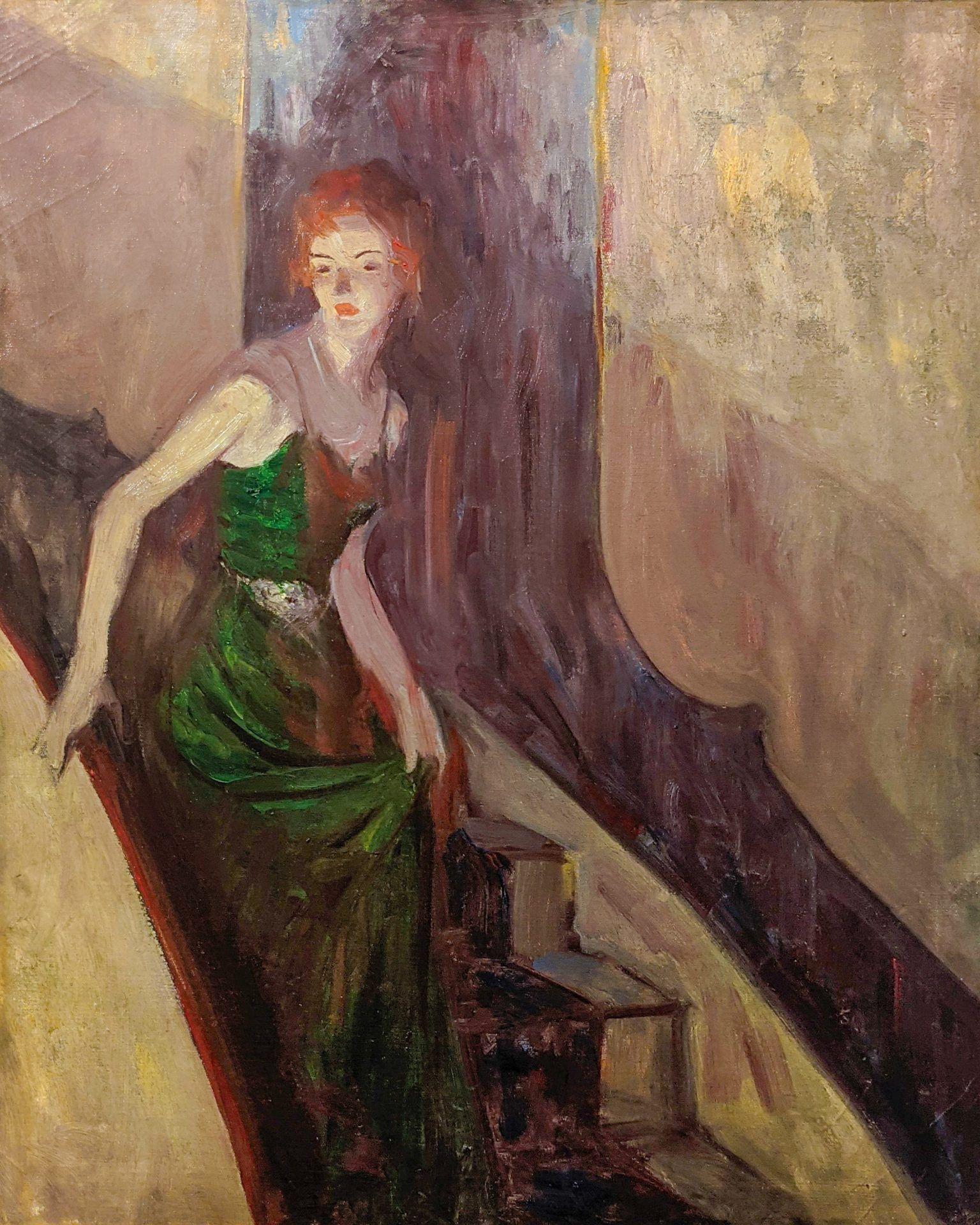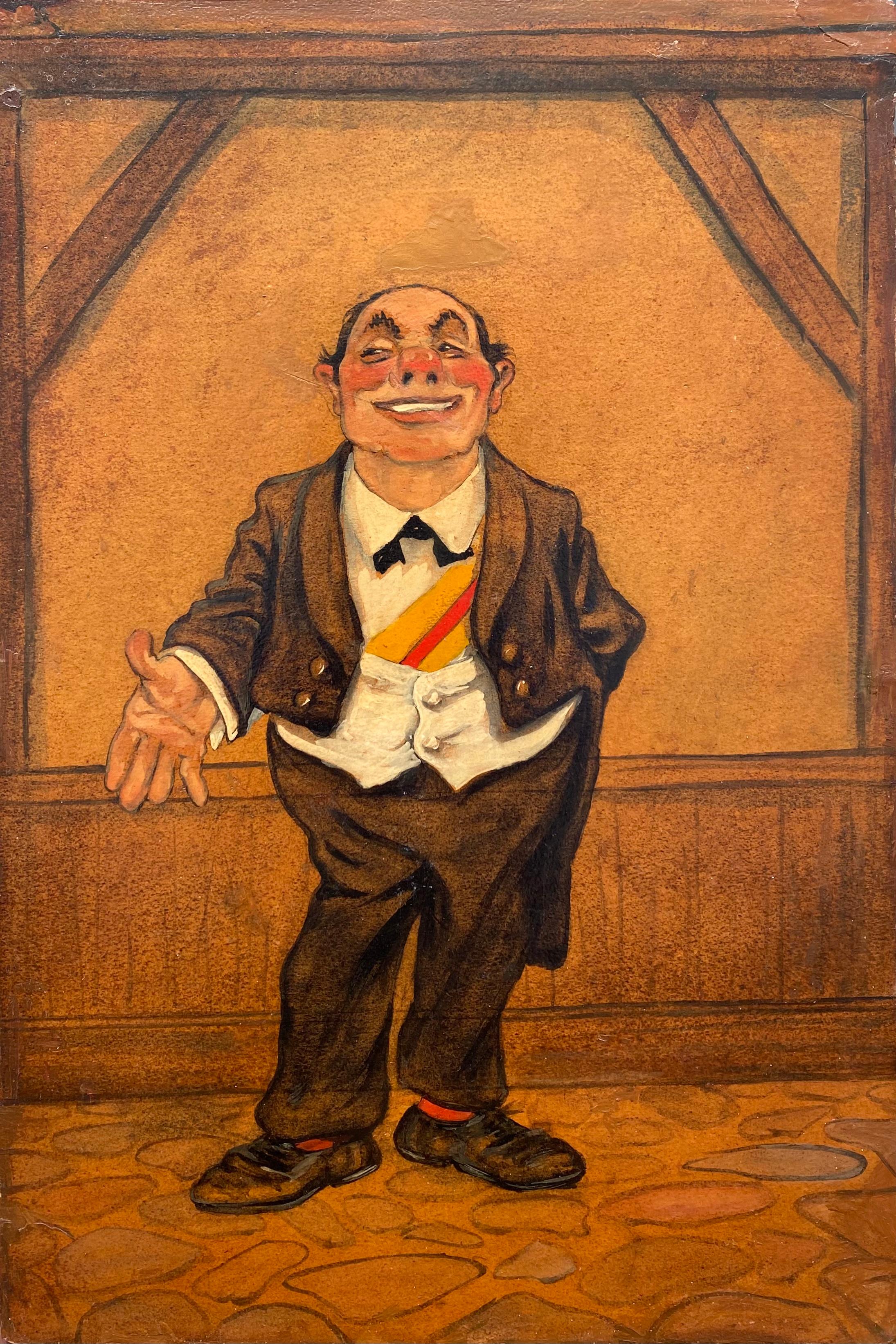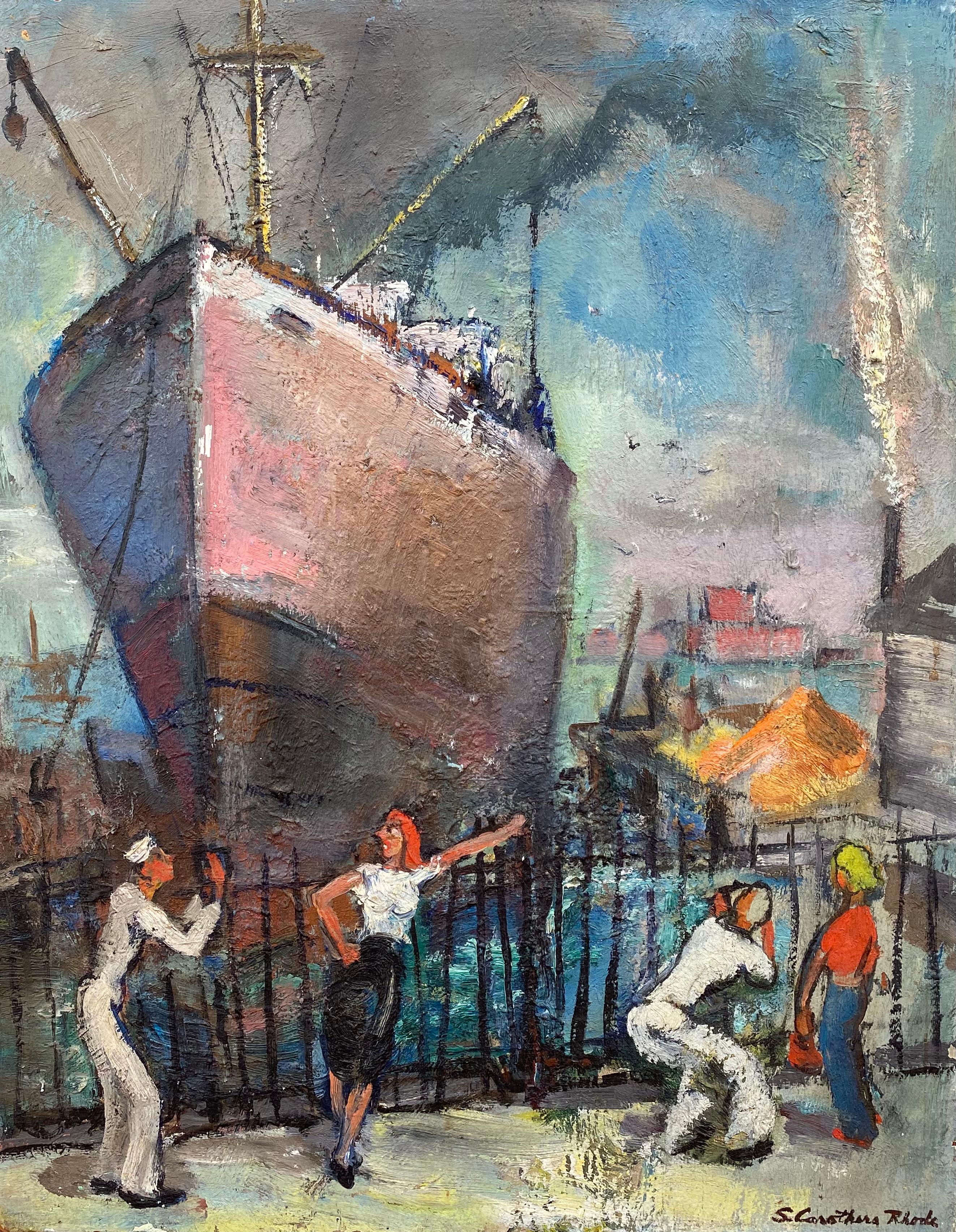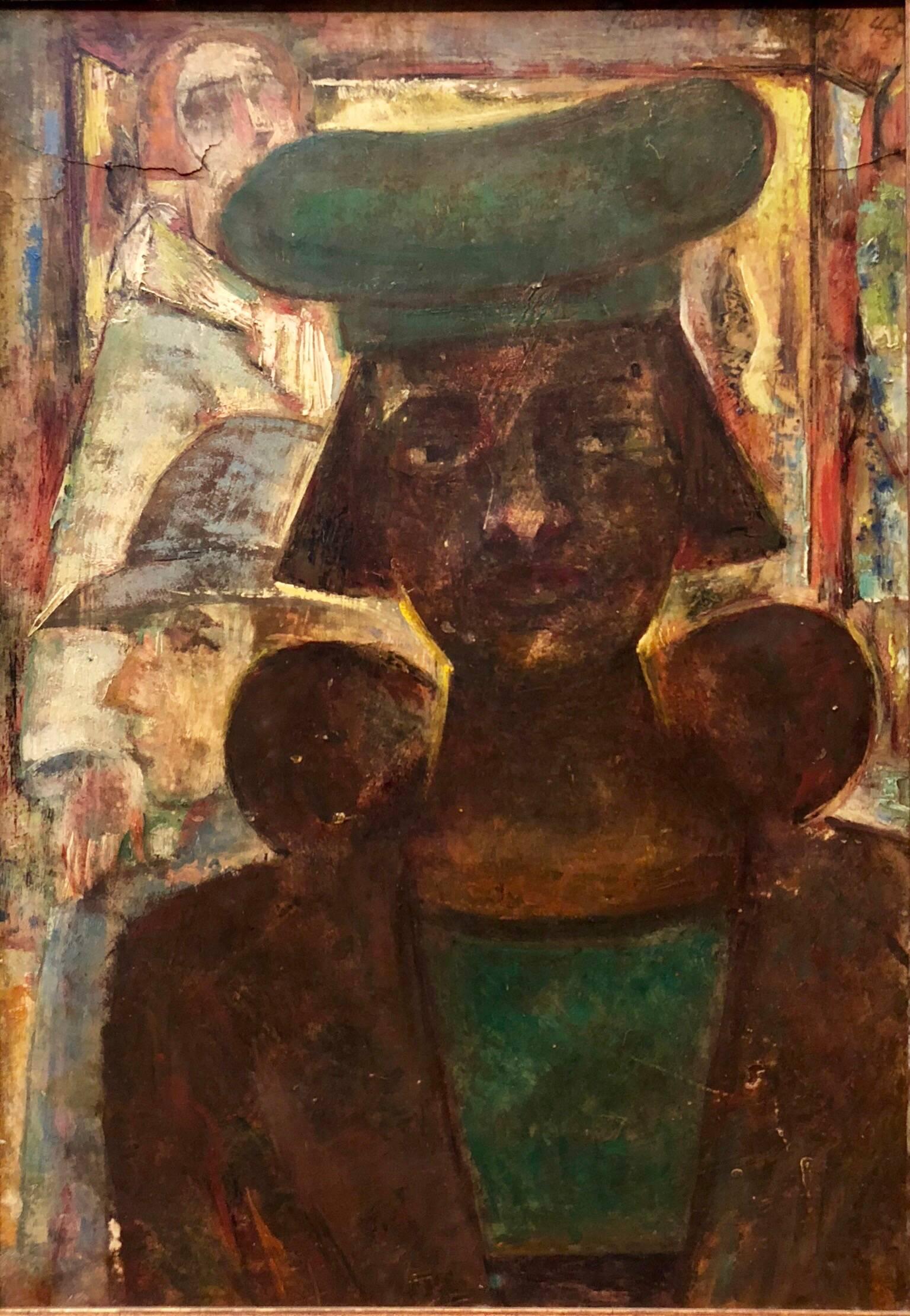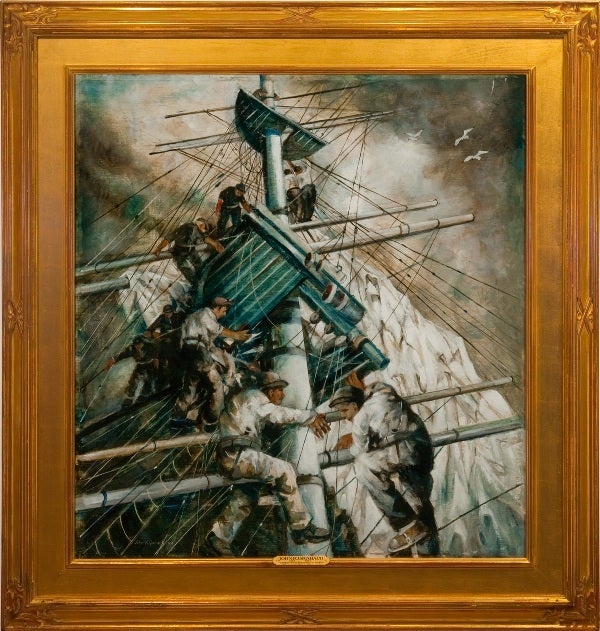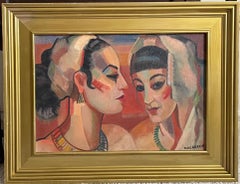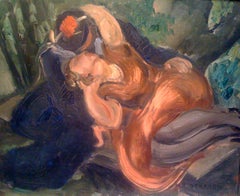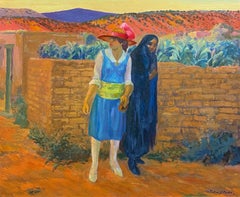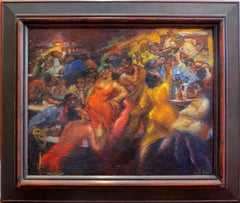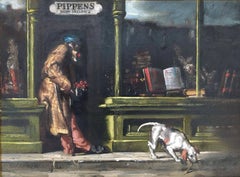
BUDDY POPPIES
View Similar Items
Want more images or videos?
Request additional images or videos from the seller
1 of 2
Earl Francis HofmannBUDDY POPPIES1955
1955
About the Item
- Creator:Earl Francis Hofmann (1928 - 1992, American)
- Creation Year:1955
- Medium:
- Movement & Style:
- Period:
- Condition:
- Gallery Location:Los Angeles, CA
- Reference Number:1stDibs: LU392201223
About the Seller
5.0
Vetted Seller
These experienced sellers undergo a comprehensive evaluation by our team of in-house experts.
Established in 1972
1stDibs seller since 2011
383 sales on 1stDibs
Typical response time: 1 hour
More From This SellerView All
- AlexandriaBy Buckley MacGurrinLocated in Los Angeles, CABUCKLEY MACGURRIN "ALEXANDRIA" OIL ON CANVAS, SIGNED, TITLED AMERICAN, DATED 1949 EXHIBITED: DALZELL-HATFIELD GALLERY 14 X 20 INCHES Buckley MacGurrin 1896 –1971 Buckley MacG...Category
1940s Art Deco Figurative Paintings
MaterialsOil, Canvas
- Sailor and LoverLocated in Los Angeles, CARoland Marie Gérardin was born in Paris in 1907. He is best known as a painter of historical, mythological, and religious subject matter as well as genre scenes. He studied with J...Category
1930s Art Deco Figurative Paintings
MaterialsOil, Canvas
- BLONDE WITH ART DECO NECKLACELocated in Los Angeles, CABiography from the niece of the artist from during his lifetime. Paintings acquired from the artist.s estate. Max Turner 1925 - 2019 Max Lamar Turner Painter, Sculptor, Teacher and Author. Max Turner was born in Omaha, Nebraska on July 28, 1925. His father was Lance Howard Turner and his mother Mary Irene Turner. In 1927, his family moved to Bingham Canyon, Utah where Max's father extracted copper from a creek that he had diverted to pass through his garage. The town was located in a narrow canyon on the eastern face of the Oquirrh Mountains. In 1938, when Max was 13, his family moved to Midvale, Utah. After completing high school, Max went to work laying rail until he was inducted into the U.S. Navy to serve during W.W. II. There he took an aptitude test and was initially assigned to the medical corp., later transferring to the dental unit. Max was stationed at Port Hueneme, Ventura County, California through the end of the war. When he was discharged in 1946, he remained in Southern California, living in the Los Angeles area. He met a man named Larry Torres and they formed a partnership to do silk screen work primarily for the Colby Poster Printing Company. This lasted about 10 years until the Colby building caught fire and burned down. In 1958, Max began working for Slade Novelty company that made doll parts using a product called plastisol. A year later, Max began producing plastic parts through his own business. One day, a couple of kids brought in a shrunken skull they had made and asked Max if he could reproduce it. Max said he could and he looked around for a business to work with for this task. He ultimately decided he could create his own machine shop to make molds. As a result, Max purchased a lathe, drill press, grinder and other tools to create his own machine shop and went into business making molds. He built a clientele and in 1973, he moved his machine shop to Glendale, California. Painter, Sculptor, Teacher and Author: Max recalls the day when his interest in art took a new direction. He happened to be in a paint store to purchase some supplies when he saw a card posted on a wall that read, "Come paint with Connie Marlo". Max had been interested in art since his youth and he was frequently impressed with paintings displayed by local artists at various community events. Consequently, he decided to go to Connie's Saturday morning art class at a studio on North La Brea Avenue (between Sunset and Hollywood) in Los Angeles. But, as fate would have it, he immediately took a detour from this class when he found a piece of paper on the floor of the studio referencing another art class dealing with compositions, patterns, rhythms and color harmony. The instructor's name was Hal Reed, a former art student of the Russian/American Master, Nicolai Fechin. Hal owned the building (previously the Will Foster Studio) and had founded the Art League of Los Angeles. When Max found Hal, he asked Hal if he could join his class. Hal said "No, the class was full" but he said Max could monitor the class in the back of the classroom. Max took him up on the offer and began observing the weekly class. During the class, Hal told his students that they should practice what they were learning by going to "live model" classes. Max began attending these classes where he learned how to draw figures. After a few months, Hal and Max became good friends. Hal was so impressed with Max's work that he offered Max the opportunity to teach at another location that Hal was opening in the San Fernando Valley. Max accepted the offer and began teaching his own art class. For Max, it was a quick jump from learning to teaching. Max then found that several of his students had to commute to his art class from the west end of the "Valley". To better serve this group of students, Max decided to relocate to another studio in Calabasas. Max continued teaching, and at this time he was producing very impressive portraits, both oil paintings and charcoal drawings from live models (Max never worked from photos). Max demonstrated real talent, and the style of his drawings and paintings were being compared to those of Nicolai Fechin. And, like Fechin, Max also had an interest in sculpting. One day, Max decided to design and cast a bronze owl sculpture to put in his Calabasas Fine Art Gallery. Later, someone approached Max when he was at the foundry and asked him about his success selling the owl sculpture. The individual who asked this question was convinced that there was a broader market for these sculptures and he ordered a dozen of the owl sculptures from Max. This encouraged Max to do more castings. Some of the new castings were antique sculptures he found and reproduced. As this new business grew, he decided to establish his own foundry, employing up to 15 workers. The business continued for many years, up until the late 1990's when Max got tired of the foundry business and sold it. Max, who was now in his 70's, decided to move on to his next venture as an artist, dedicating himself to doing the actual sculpting of original art. He loved the creativity of sculpting and he had his sculptures cast at local foundries, ironically the same ones that used to be his competition. Max was now fully engaged in his new artistic direction and, over time, he produced a large body of work. He created very impressive sculptures, including about 100 full-size sculptures. He sold some of these to high-end clientele, the Foundry at SLS Las Vegas, and to Hollywood studios. Even though Max now seemed to be totally in his element, he somehow also found time to continue to teach painting classes at the California Art Institute in Westlake Village in Los Angeles. At the institute, he specialized in figure work. Max continued to draw, paint and teach, but he says he stopped sculpting when he turned 90. Max produced four books showcasing his drawings and paintings. The first is "Faces, The Drawings of Max Turner", copyright 2000, that showcases nearly 100 of his portrait drawings. Within the "Acknowledgements" section, he lists Hal Reed and Joseph Nordmann, two former students of Nicolai Fechin. In 2006, Max produced his second book titled "Figures and Faces", reflecting not only portraits but also figure drawings and paintings. It is a wonderful book of Max's work, but it is currently difficult to find. The third book is titled "Faces 2, The Paintings and Drawings of Max Turner", copyright 2009, which includes 75 portrait paintings and drawings. In the "Preface" of this book, Max describes growing up in a small and isolated mining town during the Great Depression. He states that as a kid, he had little exposure of any culture or view of what the rest of the world was like. His neighbor was the trash collector and Max would sometimes go through his truck looking for anything of value. Among other things, he found magazines like Cosmopolitan, Good Housekeeping and Red Book, with covers that frequently showed drawings or paintings of faces. Max states that these images were the very first source of inspiration for him. He says that he began looking more carefully at people's faces and if they had character, he would draw them. By drawing them, Max says that he was making them part of his world, his world of "Faces". In 2018, Max published his newest book showcasing his drawings and paintings. It is titled "Max Turner's Figure Sketches". This softbound book includes 76 pages and over 120 drawings and paintings. In the Introduction, Max explains "I have found that when approaching the figure, one should begin with the gesture. After having captured the essence or feeling of the pose, one can then proceed to build on it." The figure sketches in this wonderful book reflect a Master's work that consistently captures the "gesture"-showing the emotion, movement and expression. Two more books are on the horizon for Max, both dealing with his passion for sculpting. His first, "The Sculpture of Max Turner" is a compilation of his commercial and noncommercial pieces throughout his career. The second, "Terra Cotta Sculpture by Max Turner" is a complete collection of figures done at the California Art Institute. These much anticipated books should be out later in 2018. Max now considers himself primarily a sculptor. But others in the art world are more than impressed with his drawings and paintings as well. His portraits are often described as having a Fechin-esque appearance, referring to the style of Nicolai Fechin. When Max observed those first art classes given by Hal Reed, it should be noted that Hal had previously been a student of the Russian/American Master Nicolai Fechin in the early to mid-1950's. In fact, Hal was a student in the last art class that Fechin taught before he unexpectedly died in 1955. Hal was so strongly influenced by Fechin that he later produced two 30-minute art instruction videos as part his Art Video Productions wherein he specifically described Fechin techniques that he learned in Fechin's class. The Fechin style and techniques were in play when Max later met Hal. Over the years, many of Max's art students, art collectors, gallery owners, as well as the Director of the Monterey Museum of Art have commented on the Fechin-esque qualities of Max's wonderful charcoal drawings and paintings. So, while Max may consider himself primarily a sculptor, his drawings and paintings are also impressive and very much sought after. When Nicolai Fechin died in 1955, three of the nine students in his last art class became life-long friends. Max subsequently became friends with not only Hal Reed, but also with prior Fechin students Joseph Nordmann and Albert Londraville...Category
1990s Modern Figurative Paintings
MaterialsOil, Canvas
$650 Sale Price48% Off - LADY WITH PICK FANLocated in Los Angeles, CABiography from the niece of the artist from during his lifetime. Paintings acquired from the artist.s estate. Max Turner 1925 - 2019 Max Lamar Turner Painter, Sculptor, Teacher and Author. Max Turner was born in Omaha, Nebraska on July 28, 1925. His father was Lance Howard Turner and his mother Mary Irene Turner. In 1927, his family moved to Bingham Canyon, Utah where Max's father extracted copper from a creek that he had diverted to pass through his garage. The town was located in a narrow canyon on the eastern face of the Oquirrh Mountains. In 1938, when Max was 13, his family moved to Midvale, Utah. After completing high school, Max went to work laying rail until he was inducted into the U.S. Navy to serve during W.W. II. There he took an aptitude test and was initially assigned to the medical corp., later transferring to the dental unit. Max was stationed at Port Hueneme, Ventura County, California through the end of the war. When he was discharged in 1946, he remained in Southern California, living in the Los Angeles area. He met a man named Larry Torres and they formed a partnership to do silk screen work primarily for the Colby Poster Printing Company. This lasted about 10 years until the Colby building caught fire and burned down. In 1958, Max began working for Slade Novelty company that made doll parts using a product called plastisol. A year later, Max began producing plastic parts through his own business. One day, a couple of kids brought in a shrunken skull they had made and asked Max if he could reproduce it. Max said he could and he looked around for a business to work with for this task. He ultimately decided he could create his own machine shop to make molds. As a result, Max purchased a lathe, drill press, grinder and other tools to create his own machine shop and went into business making molds. He built a clientele and in 1973, he moved his machine shop to Glendale, California. Painter, Sculptor, Teacher and Author: Max recalls the day when his interest in art took a new direction. He happened to be in a paint store to purchase some supplies when he saw a card posted on a wall that read, "Come paint with Connie Marlo". Max had been interested in art since his youth and he was frequently impressed with paintings displayed by local artists at various community events. Consequently, he decided to go to Connie's Saturday morning art class at a studio on North La Brea Avenue (between Sunset and Hollywood) in Los Angeles. But, as fate would have it, he immediately took a detour from this class when he found a piece of paper on the floor of the studio referencing another art class dealing with compositions, patterns, rhythms and color harmony. The instructor's name was Hal Reed, a former art student of the Russian/American Master, Nicolai Fechin. Hal owned the building (previously the Will Foster Studio) and had founded the Art League of Los Angeles. When Max found Hal, he asked Hal if he could join his class. Hal said "No, the class was full" but he said Max could monitor the class in the back of the classroom. Max took him up on the offer and began observing the weekly class. During the class, Hal told his students that they should practice what they were learning by going to "live model" classes. Max began attending these classes where he learned how to draw figures. After a few months, Hal and Max became good friends. Hal was so impressed with Max's work that he offered Max the opportunity to teach at another location that Hal was opening in the San Fernando Valley. Max accepted the offer and began teaching his own art class. For Max, it was a quick jump from learning to teaching. Max then found that several of his students had to commute to his art class from the west end of the "Valley". To better serve this group of students, Max decided to relocate to another studio in Calabasas. Max continued teaching, and at this time he was producing very impressive portraits, both oil paintings and charcoal drawings from live models (Max never worked from photos). Max demonstrated real talent, and the style of his drawings and paintings were being compared to those of Nicolai Fechin. And, like Fechin, Max also had an interest in sculpting. One day, Max decided to design and cast a bronze owl sculpture to put in his Calabasas Fine Art Gallery. Later, someone approached Max when he was at the foundry and asked him about his success selling the owl sculpture. The individual who asked this question was convinced that there was a broader market for these sculptures and he ordered a dozen of the owl sculptures from Max. This encouraged Max to do more castings. Some of the new castings were antique sculptures he found and reproduced. As this new business grew, he decided to establish his own foundry, employing up to 15 workers. The business continued for many years, up until the late 1990's when Max got tired of the foundry business and sold it. Max, who was now in his 70's, decided to move on to his next venture as an artist, dedicating himself to doing the actual sculpting of original art. He loved the creativity of sculpting and he had his sculptures cast at local foundries, ironically the same ones that used to be his competition. Max was now fully engaged in his new artistic direction and, over time, he produced a large body of work. He created very impressive sculptures, including about 100 full-size sculptures. He sold some of these to high-end clientele, the Foundry at SLS Las Vegas, and to Hollywood studios. Even though Max now seemed to be totally in his element, he somehow also found time to continue to teach painting classes at the California Art Institute in Westlake Village in Los Angeles. At the institute, he specialized in figure work. Max continued to draw, paint and teach, but he says he stopped sculpting when he turned 90. Max produced four books showcasing his drawings and paintings. The first is "Faces, The Drawings of Max Turner", copyright 2000, that showcases nearly 100 of his portrait drawings. Within the "Acknowledgements" section, he lists Hal Reed and Joseph Nordmann, two former students of Nicolai Fechin. In 2006, Max produced his second book titled "Figures and Faces", reflecting not only portraits but also figure drawings and paintings. It is a wonderful book of Max's work, but it is currently difficult to find. The third book is titled "Faces 2, The Paintings and Drawings of Max Turner", copyright 2009, which includes 75 portrait paintings and drawings. In the "Preface" of this book, Max describes growing up in a small and isolated mining town during the Great Depression. He states that as a kid, he had little exposure of any culture or view of what the rest of the world was like. His neighbor was the trash collector and Max would sometimes go through his truck looking for anything of value. Among other things, he found magazines like Cosmopolitan, Good Housekeeping and Red Book, with covers that frequently showed drawings or paintings of faces. Max states that these images were the very first source of inspiration for him. He says that he began looking more carefully at people's faces and if they had character, he would draw them. By drawing them, Max says that he was making them part of his world, his world of "Faces". In 2018, Max published his newest book showcasing his drawings and paintings. It is titled "Max Turner's Figure Sketches". This softbound book includes 76 pages and over 120 drawings and paintings. In the Introduction, Max explains "I have found that when approaching the figure, one should begin with the gesture. After having captured the essence or feeling of the pose, one can then proceed to build on it." The figure sketches in this wonderful book reflect a Master's work that consistently captures the "gesture"-showing the emotion, movement and expression. Two more books are on the horizon for Max, both dealing with his passion for sculpting. His first, "The Sculpture of Max Turner" is a compilation of his commercial and noncommercial pieces throughout his career. The second, "Terra Cotta Sculpture by Max Turner" is a complete collection of figures done at the California Art Institute. These much anticipated books should be out later in 2018. Max now considers himself primarily a sculptor. But others in the art world are more than impressed with his drawings and paintings as well. His portraits are often described as having a Fechin-esque appearance, referring to the style of Nicolai Fechin. When Max observed those first art classes given by Hal Reed, it should be noted that Hal had previously been a student of the Russian/American Master Nicolai Fechin in the early to mid-1950's. In fact, Hal was a student in the last art class that Fechin taught before he unexpectedly died in 1955. Hal was so strongly influenced by Fechin that he later produced two 30-minute art instruction videos as part his Art Video Productions wherein he specifically described Fechin techniques that he learned in Fechin's class. The Fechin style and techniques were in play when Max later met Hal. Over the years, many of Max's art students, art collectors, gallery owners, as well as the Director of the Monterey Museum of Art have commented on the Fechin-esque qualities of Max's wonderful charcoal drawings and paintings. So, while Max may consider himself primarily a sculptor, his drawings and paintings are also impressive and very much sought after. When Nicolai Fechin died in 1955, three of the nine students in his last art class became life-long friends. Max subsequently became friends with not only Hal Reed, but also with prior Fechin students Joseph Nordmann and Albert Londraville...Category
1990s Modern Figurative Paintings
MaterialsOil, Canvas
$450 Sale Price64% Off - Lounging NudeBy Reza AfrookhtehLocated in Los Angeles, CAReza begun studying art seriously at age 15 and was studying at the institute of art in Iran where he graduated with highest honors. He also studied privately with one of Persia’s m...Category
2010s Cubist Figurative Paintings
MaterialsOil, Canvas
Price Upon Request - Cubist NudeBy Reza AfrookhtehLocated in Los Angeles, CAFrame 41 x 35 inches Reza begun studying art seriously at age 15 and was studying at the institute of art in Iran where he graduated with highest honors. He also studied privately ...Category
2010s Cubist Figurative Paintings
MaterialsOil, Canvas
Price Upon Request
You May Also Like
- Mother and Daughter, Santa Fe, 1919-20By John French SloanLocated in Missouri, MOMother and Daughter, Santa Fe, 1919-20 By. John French Sloan (American, 1871-1951) Signed Lower Right Unframed: 20 x 24 inches Framed: 27 x 31.5 inches Born in Lock Haven, Pennsylva...Category
Early 20th Century Ashcan School Figurative Paintings
MaterialsCanvas, Oil
- "Jazz Club"By Jane GibbsLocated in Lambertville, NJSigned Lower LeftCategory
20th Century Ashcan School Figurative Paintings
MaterialsOil, Canvas
$31,000 - "Julie Hyneman at Central Park, New York City, " Herman Hyneman, Gilded AgeBy Herman HynemanLocated in New York, NYHerman N. Hyneman (1849 - 1907) Julie Hyneman at Central Park Oil on canvas 25 x 20 inches Signed lower left Herman N. Hyneman was a noted American portrait and figure painter with ties to both Philadelphia and New York. He was born July 27,1849 to Leon and Adeline Hyneman in Philadelphia. ("Who Was Who in American Art" lists his birth date as either 1849 or 1859, but we have confirmed that the birth date is 1849). Virtually nothing is known about his early years, but given the fact that the family resided in a wealthy section of Philadelphia and the fact that he traveled to Paris to study in the studio of Leon Bonnat when he was but 20 years old, it is presumed that the family was financially comfortable if not well to do. Hyneman exhibited at the Paris Salon in 1879 and 1881, which was quite an accomplishment given his tender age. He returned to the United States in 1882 and after a year in Philadelphia, he established a studio at 58 West 57th Street, New York, NY, where he painted portraits to support himself and scenes of beautiful fair-skinned women walking in the snow to exhibit at major exhibitions throughout the United States. Hyneman exhibited at the the Brooklyn Art Association in 1882, 1883 and 1884 and at the Pennsylvania Academy of Fine Arts in 1883 and 1888. Beginning in 1882 and continuing up until 1905, he exhibited regularly at the National Academy of Design. Despite the fact that he exhibited fourteen paintings at the National Academy over a span of three different decades, he was never elected as a member. In the 1880's his paintings sold for between $100 and $1500, which were substantial sums for that period. Hyneman also exhibited at the Salmagundi Club and the Philadelphia Art Club and was a member of each organization. He won a medal at the American Art Society in 1904 and also exhibited at the Chicago Art Institute. A handwritten label on one of his paintings indicates that he also exhibited in Budapest, Hungary. In 1892, Hyneman married the noted artist Juliet Jolley (aka Jolly), who had previously modeled for him. Thereafter, they shared a studio and on at least one occasion exhibited together. The February 5, 1896 edition of the "New York Times" reported on a "pleasant studio reception" at 58 West 57th Street where the paintings of both Herman and Juliet were shown to members of New York Society including Mr. And Mrs. Edwin Blashfield. At least one of Hyneman's Painting " A Sensation on Wall Street" which depicted a lovely young woman in fur coat with Muff in front of the Stock Exchange, was made into a post card and reproductions of his paintings are known to exist, although not plentiful. At least one etching is known, "Desdemona," which was reproduced in a book by Frederic Stokes. Herman Hyneman...Category
Late 19th Century Ashcan School Figurative Paintings
MaterialsCanvas, Oil
- "Female Nude, " Edith Glackens Dimock, Ashcan School Figurative PaintingBy Edith Glackens DimockLocated in New York, NYEdith (Glackens) Dimock (1876 - 1955) Untitled (Female Nude), circa 1915 Oil on canvas 34 1/2 x 28 1/4 inches Signed lower left Provenance: Private Colle...Category
1910s Ashcan School Nude Paintings
MaterialsCanvas, Oil
- 'The Artist as a Young Man' by Hal Frater - Ashcan School Figurative PaintingBy Hal FraterLocated in Carmel, CAHal Frater's "The Artist as a Young Man" is a striking oil on canvas that captures the essence of the artist himself, rendered in a raw, emotive style. The palette is earthy, with na...Category
1950s Ashcan School Figurative Paintings
MaterialsCanvas, Oil
$9,000 Sale Price40% OffFree Shipping - Children Playing on The Slide, Ashcan School - Lower East SideBy Jerome MyersLocated in Miami, FLImmigrant children from New York's Lower East Side are joyfully captured whizzing down on a slide. From the window of a tenement building, a lone adult with child witnesses the foli...Category
Early 1900s Ashcan School Figurative Paintings
MaterialsCanvas, Oil
